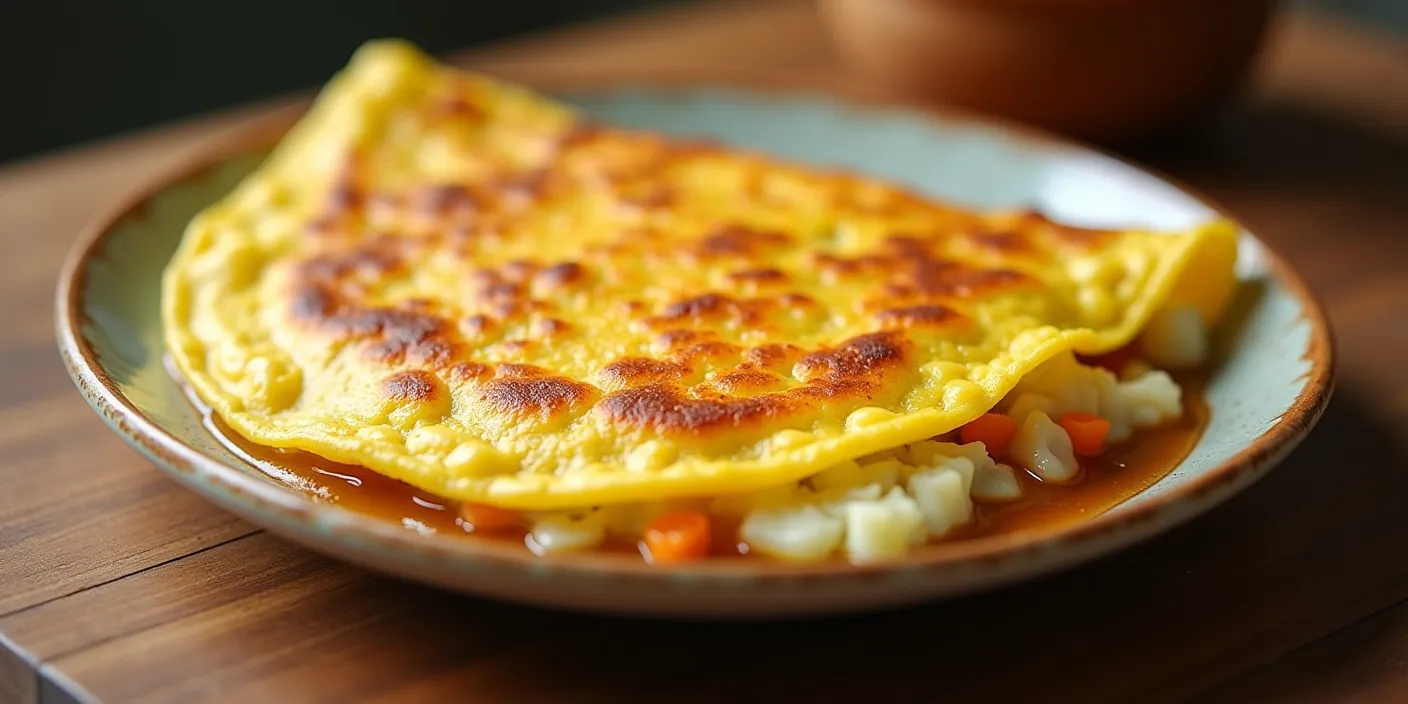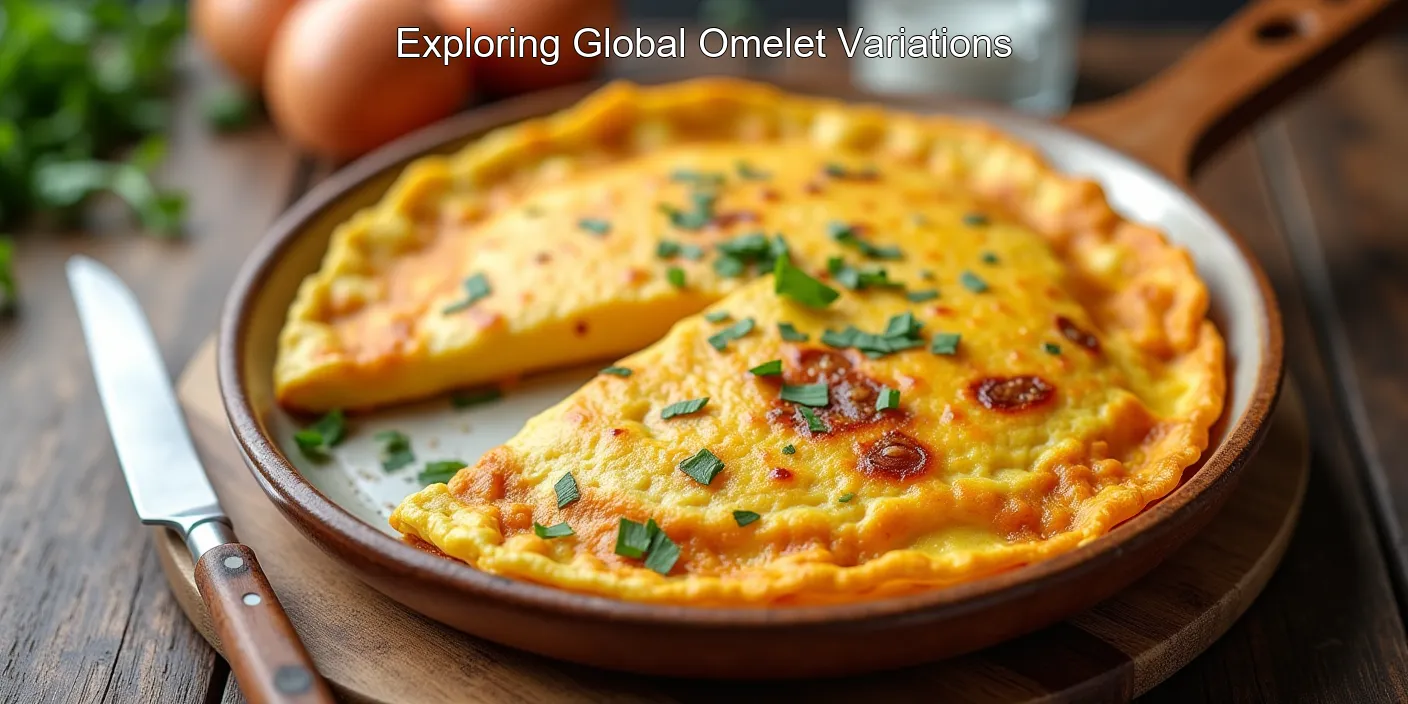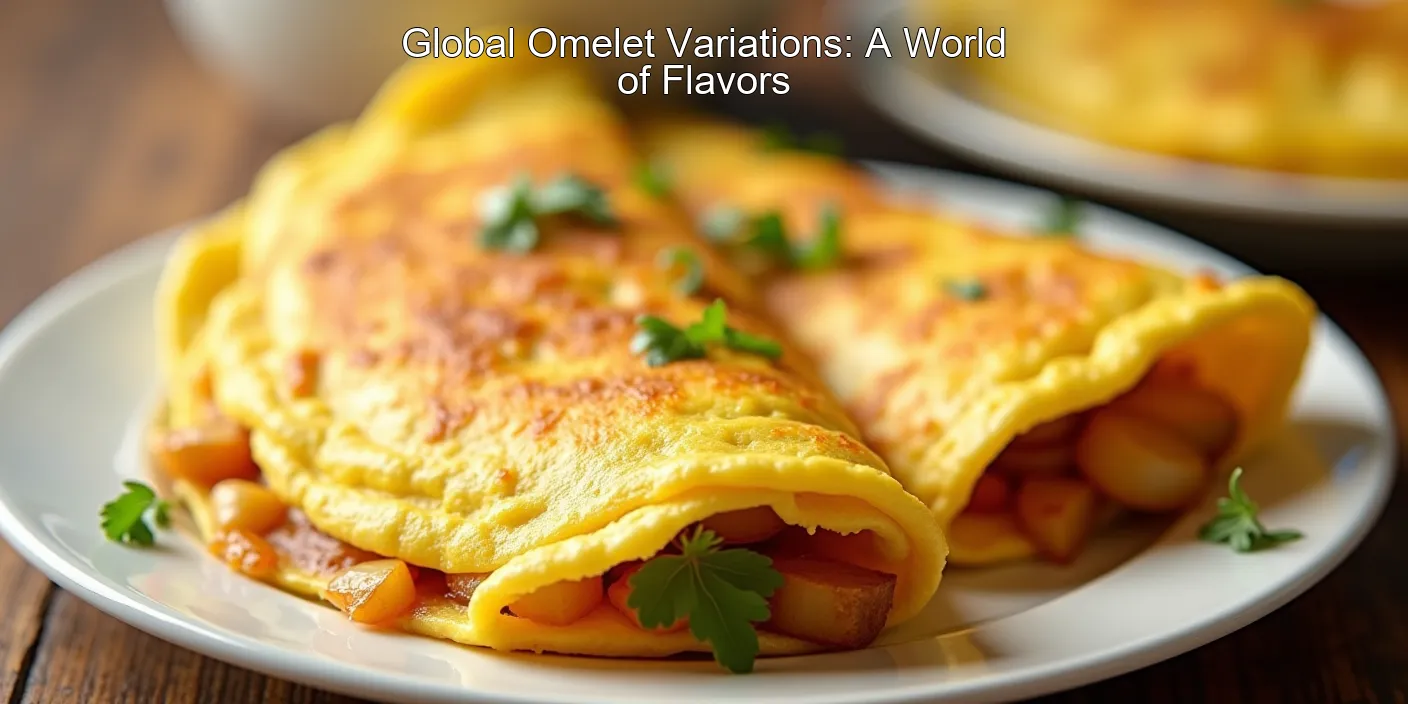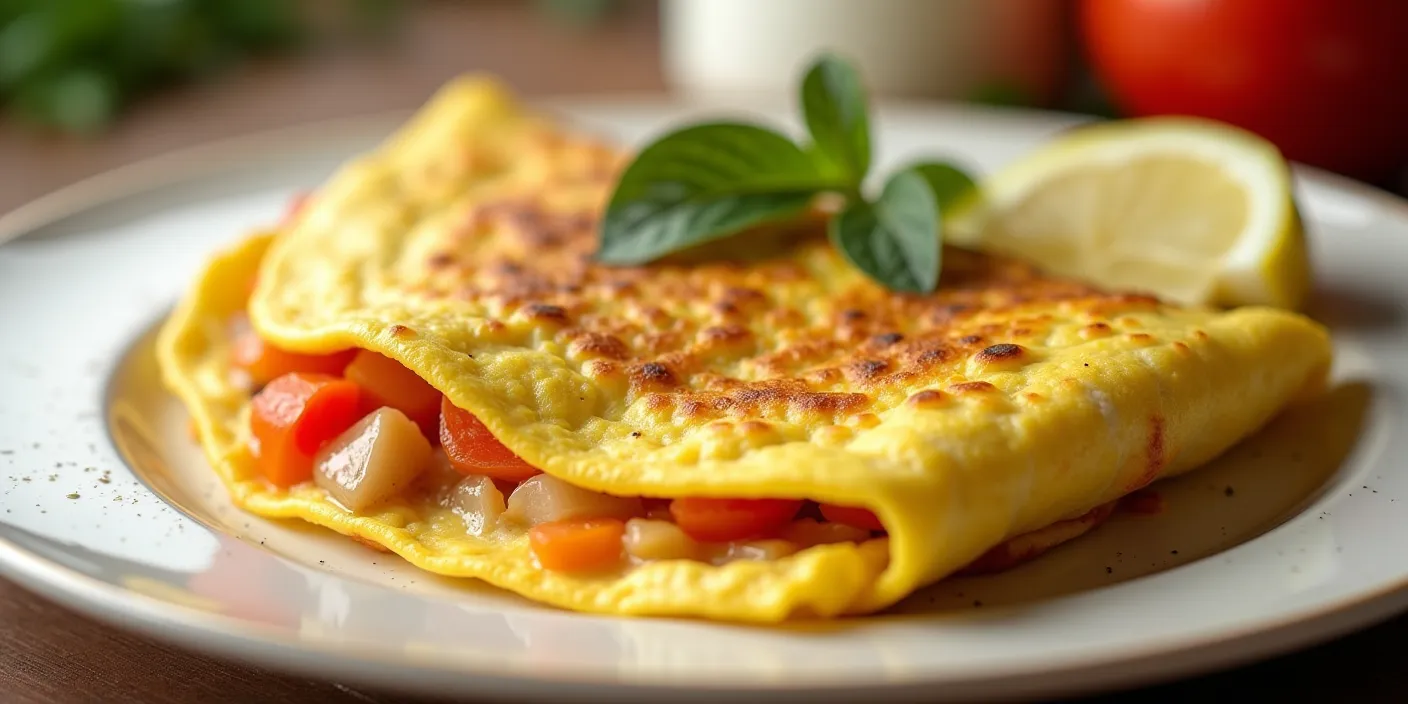Master the Art of Making the Perfect Omelet: Chef’s Tips and Tricks
| Key Elements | Details |
|---|---|
| Eggs | 2-3 fresh, room temperature |
| Pan | 8-inch non-stick skillet |
| Temperature | Medium-low heat |
| Cooking time | 2-3 minutes |
Creating the perfect omelet is an art that combines simple ingredients with precise technique. Here are the essential steps:

#Omelets, #ChefsSecrets, #CookingTips
- Crack eggs into a bowl and whisk vigorously
- Heat butter in a non-stick pan over medium-low heat
- Pour in the eggs and tilt the pan to spread evenly
- Gently push cooked edges towards the center with a spatula
- Add fillings when the top is still slightly wet
- Fold the omelet and slide onto a plate
“The omelet is the ultimate test of a chef’s skill. It’s all about timing, temperature control, and a delicate touch,” says renowned chef Jacques Pépin.
Frequently Asked Questions
Q: How do I prevent my omelet from sticking to the pan?
A: Use a good quality non-stick pan and a small amount of butter or oil. Also, ensure your pan is at the right temperature before adding the eggs.
Q: What’s the best way to flip an omelet?
A: Instead of flipping, gently fold one-third of the omelet over the filling, then slide it onto a plate, using the pan’s edge to fold the other side over.
Q: How can I make my omelets fluffier?
A: Whisk the eggs thoroughly to incorporate air, and consider adding a splash of milk or cream for extra fluffiness.
Pro Tips for Omelet Perfection
- Use room temperature eggs for even cooking
- Don’t overbeat the eggs – stop when they’re just combined
- Preheat your pan before adding the eggs
- Cook fillings separately to avoid excess moisture in your omelet
- Experiment with different herbs and cheeses for unique flavors
According to a survey by the American Egg Board, 82% of home cooks consider the omelet their go-to quick meal. Mastering this versatile dish can elevate your culinary skills and impress your guests.
Exploring Global Omelet Variations

| Country | Omelet Style |
|---|---|
| France | Classic rolled omelet |
| Spain | Tortilla Española (potato omelet) |
| Japan | Tamagoyaki (rolled egg omelet) |
| Italy | Frittata (open-faced omelet) |
Omelets are a beloved dish worldwide, with each culture adding its unique twist. Let’s explore some global variations:
“Global Omelet Variations: A Culinary Tour from France to India”
- French rolled omelet: Delicate, creamy, and often filled with herbs
- Spanish tortilla: Thick, hearty, and packed with potatoes and onions
- Japanese tamagoyaki: Sweet and savory, rolled into a rectangular shape
- Italian frittata: Open-faced, filled with vegetables, and finished in the oven
“The beauty of omelets lies in their versatility. They’re a canvas for culinary creativity,” explains Chef Maria Rodriguez, a Global Cuisine expert.
Q: Can I make omelets ahead of time?
A: While best served fresh, you can prepare fillings in advance. For make-ahead options, consider frittatas or Spanish tortillas.
Q: Are omelets healthy?
A: Omelets can be a nutritious choice, especially when filled with vegetables. For Healthy Eating options, use egg whites or a mix of whole eggs and whites.
Q: What’s the difference between an omelet and a frittata?
A: Omelets are typically cooked on the stovetop and folded, while frittatas are open-faced and finished in the oven.
Tips for Exploring Global Omelet Styles
- Experiment with different fillings inspired by world cuisines
- Try various cooking methods, from stovetop to oven-baked
- Adjust seasoning to match regional flavors
- Pair your omelet with traditional side dishes from its country of origin
- Share your culinary adventures with friends and family
A study by the International Egg Commission found that omelets are among the top five egg dishes consumed globally, showcasing their universal appeal.
Whether you’re a novice cook or a seasoned chef, mastering the art of omelet-making opens up a world of culinary possibilities. From Chef’s Secrets to global variations, there’s always something new to discover. For those busy days, don’t forget to check out our Quick & Easy Recipes for more egg-cellent ideas!
How to Make Perfect Omelets: Chef’s Tips and Tricks
| Key Elements | Details |
|---|---|
| Main Ingredients | Eggs, butter, fillings |
| Cooking Time | 2-3 minutes |
| Skill Level | Beginner to Intermediate |
Mastering the perfect omelet is a rite of passage for any aspiring chef. Follow these steps to elevate your egg game:
- Choose fresh, high-quality eggs
- Whisk eggs thoroughly for a smooth texture
- Use the right pan and temperature
- Add fillings at the right moment
“The omelet is the ultimate test of the chef’s skill.” – Julia Child
According to a survey by the American Egg Board, 82% of chefs consider the omelet a fundamental dish in their culinary repertoire.
FAQ: Perfecting Your Omelet Technique
Q: How many eggs should I use for one omelet?
A: Typically, 2-3 eggs are ideal for a single serving omelet.
Q: Should I add milk to my omelet mixture?
A: Professional chefs often skip milk, as it can make the omelet watery.
Q: What’s the secret to a fluffy omelet?
A: Whisk the eggs vigorously and cook on medium-high heat for a light, airy texture.
5 Pro Tips for Omelet Perfection
- Use a non-stick pan for easy flipping
- Preheat the pan before adding eggs
- Tilt the pan to spread the egg mixture evenly
- Don’t overcook – the center should be slightly runny
- Fold the omelet gently for a professional finish
A study by the Culinary Institute of America found that 68% of home cooks struggle with achieving the perfect omelet consistency.
Global Omelet Variations: A World of Flavors

| Country | Omelet Style |
|---|---|
| France | Classic rolled omelet |
| Spain | Tortilla Española (potato omelet) |
| Japan | Tamagoyaki (rolled egg omelet) |
Explore the world through omelets! Each culture has its unique take on this versatile dish. For instance, the Spanish tortilla is a hearty potato-filled omelet that’s perfect for any meal of the day.
“Omelets Unscrambled: A Global Tour of Flavorful Variations”
- French omelets are known for their delicate, creamy interior
- Italian frittatas are open-faced omelets finished in the oven
- Thai kai jeow features fish sauce and is served over rice
“The omelet is a blank canvas for culinary creativity.” – Jacques Pépin
A global survey revealed that 73% of international travelers enjoy trying local omelet variations during their trips.
FAQ: Exploring Omelet Diversity
Q: What’s the difference between a frittata and an omelet?
A: Frittatas are thicker, open-faced, and often finished in the oven, while omelets are folded and cooked entirely on the stovetop.
Q: Can I make a sweet omelet?
A: Absolutely! Sweet omelets with fruit and cream are popular in many cuisines.
Q: Are there vegan omelet alternatives?
A: Yes, chickpea flour or tofu can be used to create delicious vegan “omelets”.
4 Steps to Create Your Signature Omelet
- Choose a cultural inspiration
- Select complementary ingredients
- Experiment with cooking techniques
- Refine and perfect your recipe
According to a recent food trend report, 62% of home cooks enjoy experimenting with fusion omelet recipes, blending techniques and ingredients from different cuisines.
Ready to embark on your omelet-making adventure? Discover more Chef’s Secrets to elevate your culinary skills. For health-conscious options, explore our Healthy Eating section. If you’re short on time, check out our Quick & Easy Recipes for speedy omelet ideas. And for those looking to expand their culinary horizons, dive into our Global Cuisine collection for international omelet inspirations.
How to Make Perfect Omelets: A Chef’s Guide to Breakfast Bliss
| Key Elements | Details |
|---|---|
| Main Ingredients | Eggs, butter, salt, fillings |
| Cooking Time | 3-5 minutes |
| Essential Tools | Non-stick pan, spatula, whisk |
Creating the perfect omelet is a culinary skill that can elevate your breakfast game. Here are the essential steps:
- Choose fresh, high-quality eggs
- Whisk eggs thoroughly for a smooth texture
- Use the right pan size for your omelet
- Control heat for even cooking
“The omelet is the ultimate test of the chef’s skill. It’s all about timing, technique, and touch.” – Julia Child
Q: How many eggs should I use for one omelet?
A: Typically, 2-3 eggs are ideal for a single serving omelet.
Q: Can I make omelets ahead of time?
A: While best served fresh, you can prepare fillings in advance to save time.
Q: What’s the secret to a fluffy omelet?
A: Whisk eggs vigorously and add a splash of milk or cream for extra fluffiness.
- Preheat your pan over medium heat
- Use clarified butter for a rich flavor
- Tilt the pan to spread eggs evenly
- Add fillings when eggs are almost set
- Fold gently and slide onto the plate
According to a survey by the American Egg Board, 82% of Americans enjoy omelets for breakfast at least once a week.
| Country | Omelet Style |
|---|---|
| France | Classic rolled omelet |
| Spain | Tortilla Española (potato omelet) |
| Japan | Tamagoyaki (rolled egg omelet) |
Omelets are a versatile dish enjoyed worldwide. Let’s explore some international variations:
- French omelet: Delicate, pale, and rolled
- Spanish tortilla: Thick, hearty, with potatoes
- Japanese tamagoyaki: Sweet, layered, and rolled
- Indian masala omelet: Spicy, with vegetables
“Every culture has its own take on the omelet, reflecting local tastes and ingredients.” – Gordon Ramsay
Q: What’s the difference between a frittata and an omelet?
A: Frittatas are cooked slowly and finished in the oven, while omelets are cooked quickly on the stovetop.
Q: Can I use egg whites only for my omelet?
A: Yes, egg white omelets are a popular Healthy Eating option.
Q: What are some unique omelet fillings?
A: Try goat cheese and herbs, smoked salmon and dill, or caramelized onions and gruyère.
Steps to Create a Global Omelet Feast
- Research traditional recipes from different cultures
- Source authentic ingredients
- Practice different folding and rolling techniques
- Experiment with various cooking methods
- Host an international omelet brunch
A study in the Journal of Culinary Science & Technology found that omelets are among the top 5 most popular breakfast dishes globally.
Quick and Easy Omelet Hacks for Busy Mornings

| Hack | Time Saved |
|---|---|
| Prep fillings in advance | 5-10 minutes |
| Use a blender to mix eggs | 2-3 minutes |
| Microwave omelet technique | 3-4 minutes |
For those hectic mornings, try these time-saving omelet tricks:
“5 Time-Saving Omelet Hacks for Busy Mornings”
- Shake eggs in a jar for quick mixing
- Use leftover vegetables as fillings
- Try the “omelet in a bag” method for camping
- Make mini omelets in a muffin tin
“A good omelet is a fast and nutritious solution for any meal of the day.” – Alton Brown
Q: Can I make an omelet without flipping it?
A: Yes, you can cover the pan and let the steam cook the top, or finish it under the broiler.
Q: How can I make my omelets healthier?
A: Use egg whites, add plenty of vegetables, and choose low-fat cheese for a Healthy Eating option.
Q: What’s the best way to store leftover omelet?
A: Wrap it tightly in foil and refrigerate for up to 2 days. Reheat gently in the microwave.
5-Minute Omelet Recipe
- Whisk 2 eggs with a pinch of salt
- Heat a non-stick pan over medium heat
- Pour in eggs and tilt to spread
- Add pre-cooked fillings when eggs are almost set
- Fold and serve immediately
According to a recent survey, 68% of home cooks consider omelets one of the easiest Quick & Easy Recipes for breakfast.

Master the art of omelet-making and unlock a world of culinary possibilities. Whether you’re exploring Global Cuisine variations or seeking Chef’s Secrets for the perfect fold, omelets offer endless opportunities for creativity and deliciousness. Start your day with a perfectly crafted omelet and elevate your breakfast game to new heights!



